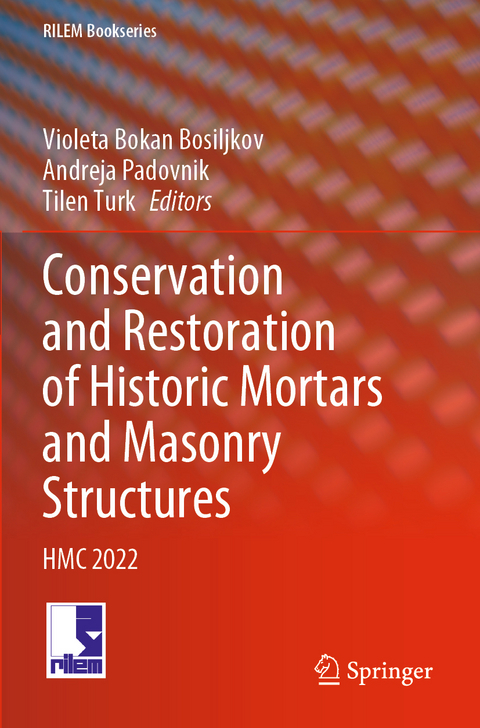
Conservation and Restoration of Historic Mortars and Masonry Structures
Springer International Publishing (Verlag)
978-3-031-31474-2 (ISBN)
This book gathers the latest advances, innovations and applications in the field of historic mortars and masonry structures conservation and restoration, as presented by international researchers and professionals at the 6th Historic Mortars Conference (HMC), held in Ljubljana, Slovenia, on September 21-23, 2022. It covers topics such as characterization of historic mortars and masonry structures-sampling and test methods; historic production, processing and application of mortars, renders and grouts; assessment of historic renders and plasters; conservation and preventing conservation case studies; repair mortars and grouts-requirements and design, compatibility issues, durability and effectiveness and adequacy of testing procedures. Special attention is given to historic mortars where one of the binders or the only binder is Portland cement and to the structures in which these materials are used. The contributions, which were selected through a rigorous international peer-review process, share new knowledge and exciting ideas that will help protect heritage buildings more efficiently and foster new multidisciplinary collaborations in this area.
Chapter Performance Evaluation of Patch Repairs on Historic Concrete Structures (PEPS): An Overview of the Assessment Methodology is available open access under a Creative Commons Attribution 4.0 International License via link.springer.com.
Imperial Styles, Frontier Solutions: Roman Wall painting technology in the Province of Noricum.- The Decorative Plastered Relief in the Baroque Villa of the Argotti Botanic Gardens, Floriana, Malta: Characterisation of Original Materials and Techniques.- A study on historic mortars for restorative applications in persepolis world heritage site: curing in site vs laboratory.- Making ancient mortars hydraulic. How composition influencestype and crystallinity of reaction products.- Physico-chemical characterization of historic mortarsfrom the Venetian Arsenals of Chania (Greece).- Analysis of the behavior of original air lime mortars used in structural brick masonry of ancient buildings.- Mineral, chemical and petrografic characterization of hydraulic mortars & chronological building correlation of the Baths of Porta Marina in Ostia Antica (Italy).- Characterization of old mortars for the formulation of replacement mortars.- Characterization of "Terranova" render samples as a contribution to XX Century heritage Conservation.- Mortars and binders during a time of emerging industries: 19th Century Austro-Hungarian fortificationsin Montenegro.- Limewashes with vegetable oils: water transport characterization.- Chemical and mineralogical characterization of lime plaster from 6th Century stone-chamber tomb of Baekje, Republic of Korea.- Characterisation of historic mortars related to the possibility of their radiocarbon dating, Mikulcice and Pohansko archaeological sites.- Repair mortar for a coloured layer of sgraffito render - a technological copy.- Evaluation of the hygroscopic and CO2 capture capacities of earth and gypsum-based Plasters.- Influence of naturalsand replacement by mineral wastes on earth and air lime plastering mortars, and professionals training.- Evaluation of physical and mechanical parametersin commercial NHL-based green plaster for the preservation of historical buildings.- Characterization of mortars and concretes from the Mirante of Quinta da Azeda, Setúbal (Portugal). A case study from the beginning of the 20th century.- Early age properties of hydraulic lime mortar prepared using heavy metal contaminated Aggregate.- Gaji, a gypsum-earth plaster in the wall painting technology of The Church of St. Demetrios of Thessaloniki, David Gareji, Kakheti, Georgia.- Performance Evaluation of Patch Repairs on Historic Concrete Structures(PEPS): An Overview of the Assessment Methodology.- Traditional techniques on Post-Civil War in Spanish Modern Architecture: the ceramic wall on OSH pavilion in the Casa del Campo (Madrid).- Measuring water absorption in replicas of medieval plaster assessing their reliability as models for conservation trials.- The sgraffito in Krizanke - interdisciplinary approach to the conservation-restoration of coloured historic plaster.- Experimentalstudy on properties of hydraulic mortars withmixed in crystallisation Inhibitors.- Utilization of lavender waste in traditional mortars.- Restoring historical buildings amid climate crisis: hydraulic, waste-based lime.- Criteria for the utilization of perlite by-products in traditional mortars.- Development and testing of lime-based mortars using perlite by- products.- Durability of lime mortarstreated with ammonium phosphate.- Long-term mechanical properties and durability of lime-spongilite mortars.- On the effect of poor-quality aggregates on the physico-mechanical performance of repair lime-based mortars.- Fine pumice as pozzolanic additive in restoration lime mortars.- The relationship between natural stone joint design, surface area and the properties of lime mortar joints.- Comparative evaluation of repair mortars for the conservation of historic masonry.- Development of a gypsum-based grout for the stabilisation of gypsum-based plasters.- Morphological evolutionof calcium carbonate crystals in dry hydrated lime mortar.- An investigation of the salt weathering resistance of heritage repair mortar mixes.- Design rationale and field testing of a gypsum-based grout for wall painting stabilization in the Chapel of Niketas the Stylite, Cappadocia, Turkey.- Comparative evaluation of properties of laboratory test specimens for masonry mortars prepared using different compaction methods.- The challenge on development of the repair mortars for historical buildings in severe marine environment: Paimogo Fort, a case study.- Practical test for pozzolanic properties by A. D. Cowper: implementation and innovation.- Determination of the salt distribution in the lime-based mortar samples using XRF and SEM - EDX characterization.- Developing a lime-based injection grout with no additives for very thin delamination: the role of aggregates and particle size/morphology.- Enhancement of latent heat storage capacity of lime rendering mortars.- Obtaining of repair lime renders with microencapsulated phase change materials: optimization of the composition, application, mechanical and microstructural studies.- Time-dependent deformations of lime-based mortars and masonry specimens prepared with them.- Influence of methyl cellulose in injection grout on mould growth on mural paintings - preliminary results
| Erscheinungsdatum | 11.06.2024 |
|---|---|
| Reihe/Serie | RILEM Bookseries |
| Zusatzinfo | XXVI, 623 p. 338 illus., 299 illus. in color. |
| Verlagsort | Cham |
| Sprache | englisch |
| Maße | 155 x 235 mm |
| Themenwelt | Technik ► Bauwesen |
| Schlagworte | Historic Mortars • Historic plasters • Historic renders • Masonry Structures • RILEM |
| ISBN-10 | 3-031-31474-3 / 3031314743 |
| ISBN-13 | 978-3-031-31474-2 / 9783031314742 |
| Zustand | Neuware |
| Haben Sie eine Frage zum Produkt? |
aus dem Bereich


